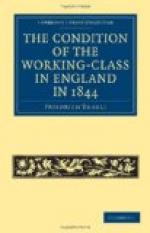the West until they reach their highest point in the
bold ridge of Blackstone Edge, the watershed between
the Irish Sea and the German Ocean. The valleys
of the Aire, along which stretches Leeds, and of the
Calder, through which the Manchester-Leeds railway
runs, are among the most attractive in England, and
are strewn in all directions with the factories, villages,
and towns. The houses of rough grey stone look
so neat and clean in comparison with the blackened
brick buildings of Lancashire, that it is a pleasure
to look at them. But on coming into the towns
themselves, one finds little to rejoice over.
Leeds lies as the Artisan describes it, and
as I found confirmed upon examination: “on
a gentle slope that descends into the valley of the
Aire. This stream flows through the city for
about a mile-and-a-half and is exposed to violent
floods during thaws or heavy rain. The higher
western portions of the city are clean, for such a
large town. But the low-lying districts along
the river and its tributary becks are narrow, dirty,
and enough in themselves to shorten the lives of the
inhabitants, especially of little children.
Added to this, the disgusting state of the working-men’s
districts about Kirkgate, Marsh Lane, Cross Street
and Richmond Road, which is chiefly attributable to
their unpaved, drainless streets, irregular architecture,
numerous courts and alleys, and total lack of the
most ordinary means of cleanliness, all this taken
together is explanation enough of the excessive mortality
in these unhappy abodes of filthy misery. In
consequence of the overflows of the Aire” (which,
it must be added, like all other rivers in the service
of manufacture, flows into the city at one end clear
and transparent, and flows out at the other end thick,
black, and foul, smelling of all possible refuse),
“the houses and cellars are often so full of
water that they have to be pumped out. And at
such times the water rises, even where there are sewers,
out of them into cellars, {40a} engenders miasmatic
vapours strongly impregnated with sulphuretted hydrogen,
and leaves a disgusting residuum highly injurious
to health. During the spring-floods of 1839
the action of such a choking of the sewers was so injurious,
that, according to the report of the Registrar of
Births and Deaths for this part of the town, there
were three deaths to two births, whereas in the same
three months, in every other part of the town, there
were three births to two deaths. Other thickly
populated districts are without any sewers whatsoever,
or so badly provided as to derive no benefit from
them. In some rows of houses the cellars are
seldom dry; in certain districts there are several
streets covered with soft mud a foot deep. The
inhabitants have made vain attempts from time to time
to repair these streets with shovelfuls of cinders,
but in spite of all such attempts, dung-heaps, and
pools of dirty water emptied from the houses, fill
all the holes until wind and sun dry them up. {40b}




